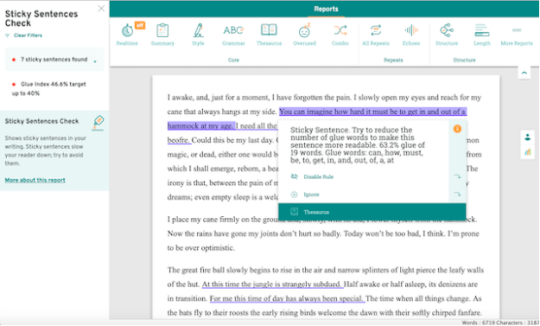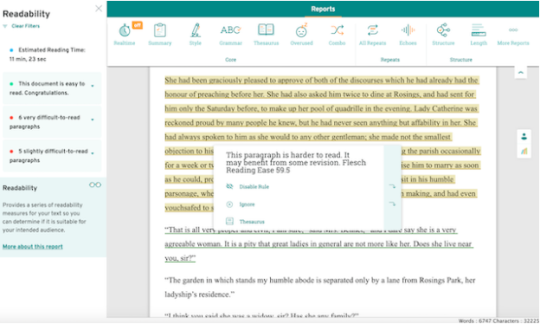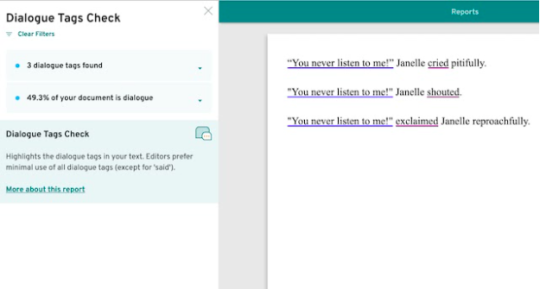3 Edits to Make Your Manuscript More Engaging for Your Readers

Every year, we’re lucky to have great sponsors for our nonprofit events. Today, ProWritingAid—a top-notch editing software—shares some tips for making your manuscript more engaging for your readers. ProWritingAid is a NaNoWriMo 2020 sponsor.
Your first draft is just that: a draft, which will likely need some significant edits to make it as engaging as possible for your readers.
As a writer, your job isn’t just to create compelling characters or craft a tantalizing plot. You also need to get your meaning across clearly and effectively. If your writing is too complicated or hard to follow, then you’re not doing your job. You might have created the coolest character in the history of the universe—but if what makes them cool is hidden in awkward and confusing sentences, then your reader will never know.
During the editing process, it’s important to hone in on sentence-level edits that can increase the clarity of your work. Let’s take a look at three issues ProWritingAid flags that can make your writing more engaging for your readers:
1. Check Your ReadabilityMany writers, especially new writers, write in a way that is difficult to follow and understand. While it may sound counter-intuitive, bestsellers are often simple and easy to read.
In the United States, the average adult prefers fiction written at a 7th–8th grade reading level (12–14 years old). Making your writing easier to read doesn’t mean that you have to dumb down your ideas—you can still have complex and entertaining stories told with simple, clear language. For instance, Hemingway wrote at a grade-school reading level.
Clear words and sentence structures make your ideas shine. Every time your reader has to stop because they didn’t follow a long, complex sentence, they will have come out of your story for a moment. That pause makes your writing less engaging.
Try ProWritingAid’s Readability Report, which flags the paragraphs and sentences in your writing that might be unclear for your readers. That way, you can edit the sentences to make them more accessible.
 2. Focus on Working Words
2. Focus on Working WordsHere at ProWritingAid, we say that every sentence has two types of words: working words and glue words.
Working words are usually nouns and verbs and they contain the sentence’s most essential information. By contrast, glue words are those that make the essential pieces of the sentence stick together. They are words that don’t carry much meaning in and of themselves, yet are necessary to create a coherent sentence.
Let’s take a look at this sentence:
Jenna hurled the basketball from half-court and watched it soar.
The italicized words are the working words. If you changed any of those words, the meaning of the sentence would shift. The rest of the words are glue words: they don’t have much impact on the sentence itself. In the above sentence, there are more working words than glue words and its meaning is clear.
If your sentences have too many glue words, they’re likely overly wordy and difficult to follow. The Sticky Sentences Report helps you identify the percentage of glue words in your sentences.

We recommend aiming for an average of less than 40% glue words throughout your manuscript. If a sentence is flagged as sticky, see if you can rewrite it in a way that is clear and concise.
For example:
Original: I went to the beach and relaxed there.
(50% glue words)
Rewrite: I relaxed on the beach.
(40% glue words)
3. Minimize Your Use of Dialogue TagsDialogue tags are the words you use to help readers understand who is speaking, especially when two or more characters are talking. The two most commonly used ones are “said” and “asked.”
You only need dialogue tags when you need to identify who’s talking. If the speaker is obvious to the reader, then skip the dialogue tags—they’ll just get in the way of your reader’s experience.
Non-standard dialogue tags like “shouted,” “whispered,” “repeated,” and “ventured” are also signs of poor writing because they tell emotions, rather than letting the dialogue and actions of your characters show their emotions.
ProWritingAid’s Dialogue Tags Check lets you instantly see how many dialogue tags you’ve used in your writing, as well as what they are. Make sure you haven’t overused dialogue tags or included too many non-standard tags that “tell” emotions.

Final Thoughts
Bestselling books don’t just have compelling characters and an engaging plot: they also have writing that is reader-focused and easy to understand.
ProWritingAid’s 20 reports highlight elements like repetitiveness, vague wording, over-dependence on adverbs, passive voice, over-complicated sentence constructions, and so much more. Our unique combination of suggestions, articles, videos, and quizzes help you master new concepts and make writing fun and interactive.
As a NaNoWriMo participant, you can get $100 off a ProWritingAid lifetime license here.

Hayley Milliman is thrilled to be
ProWritingAid
’s Content Lead, as it gives her an excuse to think deeply about words every single day. Prior to joining ProWritingAid, Hayley spent a number of years as an elementary school teacher, which was a crash course in learning how to entertain an indifferent audience. These days, she puts her storytelling skills to use writing blog articles and working on her first novel. She is the co-author of the book
Museum Hack’s Guide to History’s Fiercest Females
(which was an Amazon bestseller) and
How to Build Your Author Platform on a Shoestring
.
Chris Baty's Blog
- Chris Baty's profile
- 63 followers



